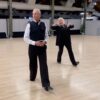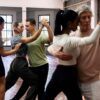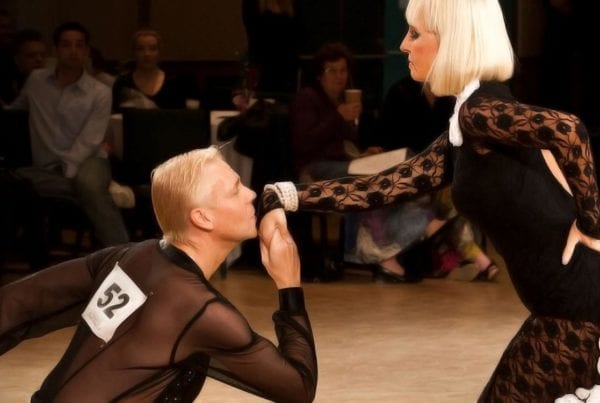To understand why it’s so easy to use “Latin,” or Ballet, feet when we dance, one only has to look at a chair.
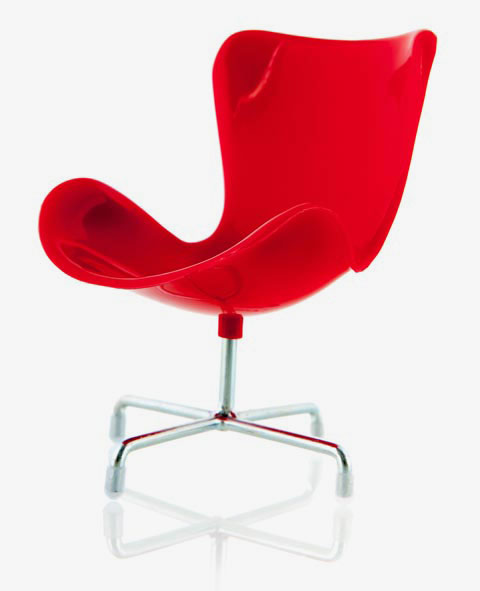 While office chairs today have five legs for stability, chair designers realized a very long time ago that spreading the feet apart into two opposite directions made the chair more stable than if its feet both faced in the same direction, especially if they were close together. When dancing, having feet spread apart is great for Latin, but not for Standard.
While office chairs today have five legs for stability, chair designers realized a very long time ago that spreading the feet apart into two opposite directions made the chair more stable than if its feet both faced in the same direction, especially if they were close together. When dancing, having feet spread apart is great for Latin, but not for Standard.
Yet far too often we see Latin feet in the Ballroom (or Standard) dances. Having watched hundreds of dancers at three competitions over five weeks, I was amazed how often the feet were pointed incorrectly.
It’s ugly, inefficient and yields a host of partnership issues that affect your ability as a dancer.
It is essential to turn the feet out slightly in the Latin genre, but it works against you in Ballroom or Smooth dances. Unfortunately, we see it all the time, even at the highest levels. Forward and backward walks, and especially Promenade movements are being done with the feet turned out.
Many dancers are not aware they are doing this with their feet. Coaches mention it but are often so focused on correcting other issues that this may not get a lot of attention. The longer it goes on the more this becomes a habit. And this can a hard habit to break, especially for someone dancing both Latin and Standard genres.
Natural form of stability
If you watch how babies first learn to stand and walk, you’ll notice that they spread their feet apart into this out-turned stance. It’s the most natural thing in the world to create stability for our bodies in this way. We don’t even think about it! By spreading the feet apart we create a slightly larger area of balance underneath our bodies. This helps us be more stable during new or unfamiliar movements.
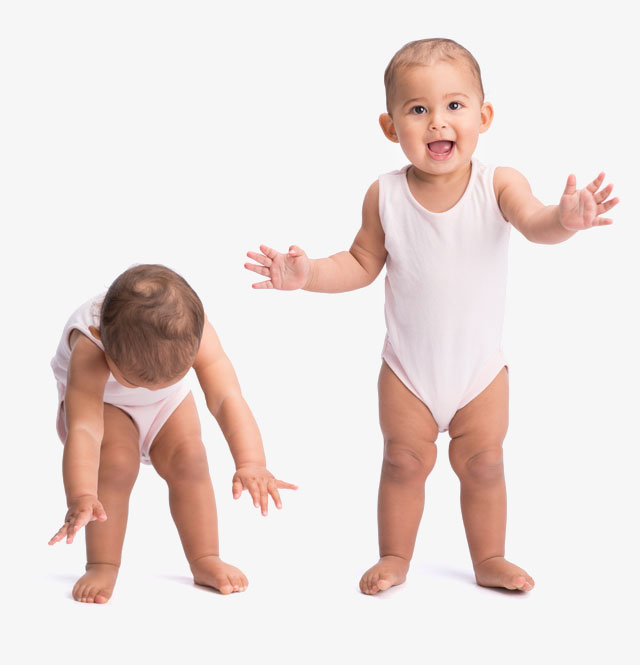 In Latin, where body weight is aligned over the balls of the feet, this makes us more stable. In addition, because of the rapid swiveling action needed to turn in the Latin and Rhythm dances, having our feet turned out helps us make the turns more efficient.
In Latin, where body weight is aligned over the balls of the feet, this makes us more stable. In addition, because of the rapid swiveling action needed to turn in the Latin and Rhythm dances, having our feet turned out helps us make the turns more efficient.
There are relatively few times in Latin where we walk forward or backward in a straight line. Even when we do, as in Rumba Walks or Plaits in Samba, hip rotation coordinates with the foot placement so the feet aren’t turned out as much as you might think. In other steps the ankles are connected to allow rapid changes in straightening and bending the knees. When the ankles connect the feet naturally point slightly away from each other. This makes the knee action faster and cleaner than if the feet were perfectly parallel.
If you watch how babies first learn to stand and walk, you’ll notice that they spread their feet apart, which makes them more stable.
In the Standard dances all of this is thrown away. Having feet turned out causes a wide variety of issues, notably having one partner’s foot blocking the path where the other needs to step. Even in Tango, which is not a swing dance, both feet are almost always aligned to face in the same direction. In some ways this goes against our natural instinct, but it makes sense when you consider the dynamic aspects of these dances.
Ballroom is different from Latin
Ballroom dances move just as much as Latin, but in a completely different way. In many of the Ballroom dance patterns, the body is in constant horizontal flight. It may be going forward, backward, or to the side, but there are relatively few places in Ballroom where we are grounded to the floor in the same way that we are in Latin. The type of movement is very different.
In addition, the bodies are positioned more closely together than they are in Latin. Feet can easily get tangled up. When we turn out our feet we run a much higher risk of having our foot blocking our partner’s path. Even a slight turnout can get in the way, causing one of the partners to step on the other or stumble over the foot.
Foot position and body flight
In many of the Ballroom dances, we swing one foot past the other. For example, in a Waltz Natural Turn the moving foot swings past the standing leg to create the dynamic energy required for a beautiful turn. If the standing foot isn’t positioned in the optimal way, it can both inhibit the momentum of this swinging action and have no power left for the next action to take place. Even as the moving foot swings by, the standing foot begins to swivel so that by the end of the swing both feet are aligned to point in the same direction. As they close, both feet continue to remain aligned even as they complete the turn.
Not only does this matching alignment look beautiful but it provides the most efficient position for every action that the feet need to take.
This is especially important for actions that require very strong body flight, such as the Feather Step or Reverse Wave in Slow Foxtrot, or forward Walks in International Tango. If the feet are not perfectly aligned in the direction of travel, they lose much of the power that is needed to push off the floor.
If the feet are not perfectly aligned in the direction of travel, they lose much of the power that is needed to push off the floor.
Think about how we move when we walk or run in normal everyday activity. We place a foot in front of our body, we arrive over that foot, then we push away from the ball of that standing foot as we repeat these actions with the other foot. If the feet were not aligned, pushing away from the ball of the foot would be inefficient because we would have a smaller surface area from which to push. You would be pushing off just one toe instead of all five. By keeping the feet aligned, we are able to push off with a maximum surface area. This creates the potential for strong movement.
When we normally walk backwards (okay, it doesn’t happen much normally), we push off the heel of the standing foot, essentially pushing the floor away from us. But even though we use the heel, the same principle applies. By using the heel in perfect alignment, we actually have more power for this push than if we had the foot turned slightly to the side, thus using only the corner of the heel.
What about Tango?
In Tango we have this unique issue happening throughout the dance where the alignment of the feet is not the same as the direction of movement (this happens in other dances as well). For example, in all Promenade movements the feet are aligned in a slightly different direction than we are moving.
Many times in Tango, and of course other Ballroom dances, both partners have their feet turned at a 45 degree angle to the direction of movement, exactly 90 degrees opposite to each other. For each partner, both feet point the same way but at right angles to the direction of the partner’s feet.
It might be argued that when the feet are turned diagonally while we are moving down the line of dance, that we are moving less efficiently. That’s probably true.. It can’t be quite as efficient for the movement itself when this diagonal alignment of feet takes place. But it is still vital to have both feet aligned in parallel even at an angle. By aligning the feet the way they do, we can move together more efficiently than if they were not aligned that way. And moving together is the whole point of ballroom dancing.
Tango has other areas where parallel feet are of great importance. Some side steps use the “inside edge” of the foot to rapidly stop the sideways momentum, much in the way a tennis player uses the inside edge of the foot to stop and change direction. If the foot were not parallel to the other foot, we would not have a full edge to work from for this staccato stopping action.
In steps like the Closed Promenade the lady turns her right foot sharply to a turned-in alignment on step 3, which contributes to her head turn and creates a beautifully crisp action. If her foot was not properly aligned on step 2 (for example pointed down the line of dance instead of DC) she would find it hard to turn it that far inward on the next step.
Not only does matching alignment look beautiful but it provides the most efficient position for every action that the feet need to take.
Foot Alignment in Turns
One of the most unattractive things that happen in the Standard dances is placing the foot in the direction of a turn before the turn begins. We often see the man leading a Natural Turn by turning his foot out even before his body begins to turn. This is pretty ugly and also takes away from the ability to move properly through the turn. The feet should always be aligned properly, turning only as the body turns, not before.
When moving forward in a Natural Turn, for example, there is 1/4 turn between steps 1 and 2. There is an additional 1/8 turn between steps 2 and 3. We do not turn the foot before step 1. We step forward in the direction of travel, then swivel the standing foot as the moving foot swings past. By the time the moving foot arrives in position, the standing foot has swiveled so that is now turned 1/4 to the right from its starting position. At this point both feet are side by side, perfectly aligned. As they close, they remain perfectly aligned but continue to turn together as the right foot moves toward the left (standing) foot. Don’t try to cut corners by turning the foot early.
This is an especially common problem in Viennese Waltz due to the faster tempo of the dance. Far too often dancers turn the foot out well before they begin turning. This leads to an overturned foot position throughout the dance and overturning the bodies due to the momentum of the turns. The foot should turn with CBM only 1/8 of a turn between the previous step and beat 1 of the music. By turning the foot with the body rotation you won’t have a turned out Latin foot.
Correcting bad habits
One of the best pieces of advice I’ve heard to correct this habit is to step in a way that feels “pigeon toed.” When you have a bad habit like using Latin (out-turned) feet, that incorrect action feels normal because you’re used to it. Breaking it requires you to feel “not normal” so that you can correct the problem. You’ll have to focus on moving forward and backward in a way that makes you feel as if your toes are turned in. When they feel like that, chances are that they will be aligned just right. Have someone monitor this with you to see how much it has to feel awkward to be properly aligned. Once you know how it feels to use the correct alignment, then focus on feeling that for the next few weeks. If you aren’t feeling it, you might be falling back on old habits.
After a number of weeks of focusing on feet alignment in this way, you will be less conscious of feeling awkward. Eventually it will begin to feel quite natural. And as that happens, you will find that your feet are correctly aligned most of the time.




